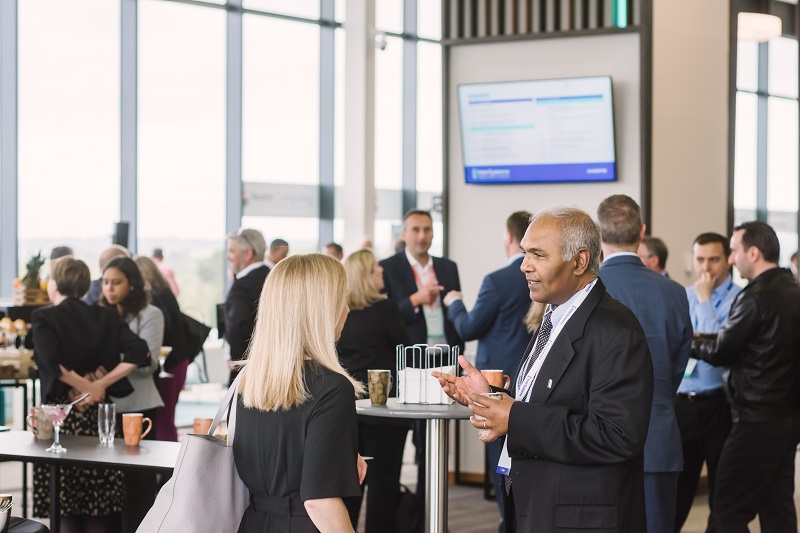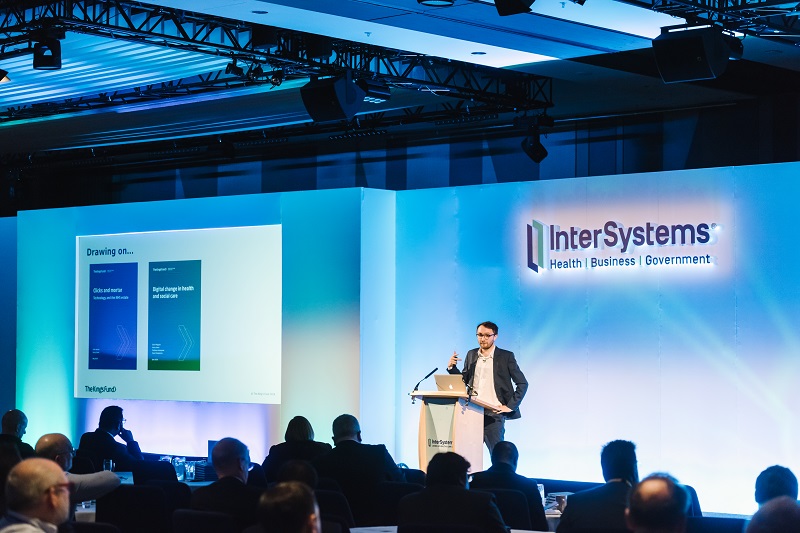Digital transformation in the NHS can at times feel like climbing a mountain.
At first it seems impossible to reach the top. But, once a path has been forged, many can follow.
This was a comparison demonstrated by Cathy O’Dowd, the first woman to reach the summit of Mount Everest from both the north and south sides.
Speaking at InterSystems’ Joined Up Health and Care conference, O’Dowd told delegates at the Vox in Birmingham that when she tackled the rocky giant years ago, it was a huge achievement.
Once something for the pioneer, ‘now Everest has become something slightly different’, she said, and suggested that ‘it has become a commodity’ with over 800 people a year making it to the top, thanks to fixed lines now in place for climbers to follow.
But, as she pointed out, there is always a new mountain to climb.
And only through meticulous planning and drawing on previous experiences can we achieve what had not been done before.
Health and care pioneers climbing the digital mountain
And, at a conference focused on ideas and best practice around the digitisation of healthcare, parallels could be drawn.
The efforts of North Tees and Hartlepool NHS Foundation Trust were highlighted by InterSystems sales director, Chris Norton, during his opening address as a pioneering trust that is reaching new heights in digital transformation.
Just days before the conference, the trust had been awarded two national Health Tech Awards following its work as the first site anywhere in England to use InterSystems TrakCare, for which it has been praised for always being prepared to lead the way and adopt something new.
We have the talent. We can do the planning. We can dig deep and go further and achieve more than we ever thought. But, to make it happen, we have to raise our eyes to those distant horizons, set our sights on those really ambitious goals, and then make it happen
And digital leaders, Liz Jones and David Smith, from Lincolnshire Sustainability and Transformation Partnership (STP), told delegates how Lincolnshire is exploring untrodden ground in its digital programme to join up care in the fourth largest county in England.
So far, the programme has seen the creation of a care portal, a patient portal, and digital care plans using InterSystems HealthShare.
“When you are first of type, it is easy to underestimate how much work there will be and how much effort it is going to take,” said Jones, the STP’s digital project manager.
“We can’t just look at an organisation that has done it; we have to do it.”
Already helping thousands of health and care professionals and their patients, many of whom live in deprived areas, the care portal has created an integrated care record and can issue alerts to relevant professionals in scenarios when a particular patient is admitted to hospital, for example.
People with authorised roles can access appropriate information in the record from different providers.
And the integration of acute systems and services, such as the national Child Protection-Information Sharing System, has made an impact from day one.
“Some of the tipping points for us have been including hospital letters, and also discharge summaries,” said Smith, the STP’s digital programme lead.
“That has made a big difference to GPs and community teams, and there is some evidence that length of stay is being reduced.
“We hope that is because community services can see the discharge letters and rally round to help them.”
Wider feedback is equally positive, said Jones. “We have got better decision making, better patient management, and also significant improved patient experience, because people are sick of repeating their story over and over again.”
The care portal is set to become ever richer as data continues to be embedded from different providers, such as Lincolnshire County Council and mental health services, while the project is a first of type for NHS Digital for GP Connect for structured data.
“We are in the final stages of testing for that,” said Smith. “It is challenging in terms of due diligence, because we need information sharing agreements in place with all our GPs.”
He added: “We are also working with maternity and with the ambulance service to surface their electronic record. So, there is lots going on. We are talking to some of our neighbour trusts, to try and pull in some of their patient administration system information.”

The conference focused on ideas and best practice around the digitisation of healthcare services
Don’t just copy and paste
Ramon Vullings, author, cross-industry expert, and ‘idea DJ’ attempted to ‘blow minds a little bit’ by giving delegates an engaging dialogue around concepts of cross-organisational working that complemented the real-world example seen in Lincolnshire.
When you are first of type, it is easy to underestimate how much work there will be and how much effort it is going to take
A man who is repeatedly engaged by space agency NASA to instil different ways of thinking, he urged attendees to break out of their silos, to find the right partners, and to find new ways of working.
But, in an age when the NHS is trying to create digital blueprints, he also urged attendees not to just ‘copy and paste’ what has been done before.
This was a message reiterated later in the conference by InterSystems’ physician executive, Dr Yossi Cohen.
Exploring prevention in Integrated Care Systems, or ICSs, Cohen pointed out that despite being one of Health and Social Care Secretary, Matt Hancock’s, three current priorities, prevention was not a new idea.
He referenced an NHS book from 1976 entitled Prevention and Healthcare: Everybody’s Business and told delegates: “You are all immunised. You all participate in screening programmes. Prevention is not new.”
But with prevention a pervasive challenge, he asked delegates how they would solve the problem, giving them all an honorary promotion to the head of an ICS.
They each needed the Cookbook for Integrated Care, something that does not exist.
So the audience needed to write its own book.
A good place to start, Cohen suggested, is ‘to ask the clinicians in your region for recipes’.
Although with many clinicians not even likely to know what an ICS is, there was big hurdle ‘to win hearts and minds’, he added.
Other places to start included existing recipes, and to see if good ones were being followed and how they could be adapted.
Evidence based care ‘for me’
Charles Alessi, chief clinical officer for global healthcare informatics society, HIMSS, and a senior advisor to Public Health England, took themes of adaption and prevention to delegates from a different perspective.
Considering we now wanted evidenced-based care ‘for me, for the one’, he asked: “Why do we always screen patients of a certain age, and of a certain sex, when we now know there are better ways to segment populations so you screen perhaps fewer people, some of them older, some of them younger. You can use your resources far more effectively and even do things you never thought possible.”
Tongues of FHIR
Interoperability standard HL7 FHIR – or Fast Healthcare Interoperability Resources – would also enable new things.
A panel discussion chaired by InterSystems director of communications, Tom Keppeler, with NHSx lead architect, Ian Townend; InterSystems HealthShare sales engineering lead, Steve Mallam; and healthcare executive advisor, David Hancock, explored the real meaning of this for healthcare.
Why do we always screen patients of a certain age, and of a certain sex, when we now know there are better ways to segment populations so you screen perhaps fewer people, some of them older, some of them younger. You can use your resources far more effectively and even do things you never thought possible
For Hancock, who is also the industry co-chair for the standards and interoperability group INTEROpen, one of the really exciting opportunities was to use FHIR to ‘bring healthcare into the internet age’ by supporting REST APIs.
“It will also enable us to bring more developer talent into healthcare, because all the young data scientists out there are familiar with REST,” he said.

Mathew Honeyman of the King's Fund health think tank said there were opportunities to learn and understand the problems health services are facing
Machine learning
With a new generation of developers often interested in the potential of artificial intelligence, Alex MacLeod, InterSystems manager for HealthShare Commercial Initiatives, detailed how the company had been applying machine learning to ‘big problems’ faced by healthcare – such as the cost of administration.
Specifically, she said: “We have been looking at appointment no-shows; which cause problems because they leave clinicians idle.”
Airlines are famous for overbooking. MacLeod demonstrated how a machine learning algorithm could intelligently predict when a patient had a high probability of not attending, and that it could create rules to also allow clinics to overbook intelligently when this was the case.
Learning from each other, integrating ideas
InterSystems chief executive and founder, Terry Ragon’s, video address emphasised that the conference was ‘a learning opportunity for us, and I hope a learning opportunity for you’.
It was a message supported by Matthew Honeyman, a researcher at The King’s Fund, who in his address around the themes of digital change in health, said that papers and reports could be ‘pretty lame’, emphasising that conferences were opportunities to ‘learn, influence the conversation around national policy, work with other systems to understand the problems they are facing’.
And it was working with others that keynote speaker, O’Dowd reflected on her own conclusions.
Describing an intense experience climbing the Mazeno Ridge that lasted far longer than the 10 days intended, she explained how after passing further than anyone had ever gone on the ridge, the majority of the climbers, herself included, did not reach the top, deciding eventually to come down.
Despite careful planning, inadvertent events, the resulting pressure on the team, and a lack of communications between the climbers meant that suddenly they were off track.
“There was success, but we could have done better, and I regret the mistakes I made early on”, she said.
And she added that a key mistake was that ‘we failed to integrate the team’, which was a mix of European and Sherpa climbers and failure to fully understand each’s strengths and weaknesses, wasting time and resources – in this case their food supplies.
Finishing the conference on a positive message, she said: “We have the talent. We can do the planning. We can dig deep and go further and achieve more than we ever thought.
“But, to make it happen, we have to raise our eyes to those distant horizons, set our sights on those really ambitious goals, and then make it happen.”
